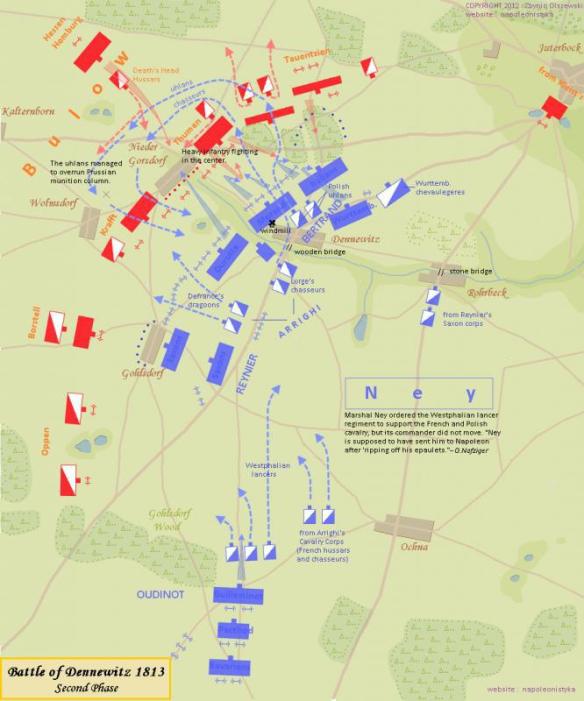The Battle of Dennewitz, 6 September 1813 – Alexander Wetterling
The Battle of Dennewitz, fought during the 1813 campaign in Germany, took place just south of Berlin, between the (French) Army of Berlin, under Marshal Michel Ney, and the (Allied) Army of the North, under the Crown Prince of Sweden, formerly one of Napoleon’s marshals, Jean-Baptiste- Jules Bernadotte. It was Napoleon’s second attempt to seize Berlin during this campaign and was as unsuccessful as Marshal Nicolas Oudinot’s first attempt, which ended at the Battle of Grossbeeren.
The Army of Berlin consisted of IV (under General Henri-Gatien Bertrand), VII (under General Jean Reynier), XII (Oudinot) Corps, and the III Cavalry Corps (under General Jean-Toussaint Arrighi de Casanova), about 58,000 men with 199 guns. The Army of the North consisted of III (Friedrich Graf Bülow) and IV (Friedrich Bogislav Graf Tauentzien) Prussian Army Corps, General Ferdinand Winzegorode’s Russian corps, and Baron Stedingk’s Swedish corps, around 120,000 men. Of these, around 43,000 Prussians were involved in the battle, although reinforcements were close to hand, some of which were committed at the end of the battle.
The terrain consisted mainly of open fields covering gently undulating hills with some small woods. The banks of the Ahe brook that ran through both Dennewitz and Jüterbog were marshy and could only be crossed at the bridges at Dennewitz, Rohrbeck, and Jüterbog.
On 5 September, Ney’s army commenced its march on Berlin, moving toward Zahna and Jüterbog. Oudinot made contact with the Allied outposts almost immediately and brushed them aside. Tauentzien fell back to Jüterbog. Receiving news of the French movement, Bülow marched off to support Tauentzien.
The next morning Bertrand clashed with Tauentzien’s shaky militia at Dennewitz, gaining the crossing there. The Prussian militia delayed Bertrand long enough for Bülow to arrive. Tauentzien’s cavalry covered the withdrawal of his infantry.
That afternoon, Bülow engaged Bertrand, who had now crossed the Ahe and deployed, and Reynier, who had drawn up to the south of the brook. Attack was followed by counterattack in what constituted some of the bitterest fighting of the fall campaign. Charles Antoine Morand’s artillery of Bertrand’s corps threw back the first Prussian assault made by General Heinrich von Thümen’s brigade. A brigade under Ludwig, Prince of Hessen-Homburg then forced Morand to retire. Reynier’s Saxons then came into action along a line from Göhlsdorf to Dennewitz.
Knowing that the Swedes and Russians were moving to assist him, Bülow decided to make a further determined effort before any more French reinforcements arrived, sending in General Karl von Borstell’s brigade. He captured Göhlsdorf, but could not make any further headway against Reynier.
About 3:30 P. M., Oudinot arrived. He immediately attacked Göhlsdorf and recaptured it. Bülow’s men were exhausted, the reinforcements were still some way off, and his artillery failed to silence Ney’s. Victory was at hand when Ney ordered Oudinot from his left to his right, which Oudinot did despite remonstrations from Reynier. This gave Bülow the opportunity to counterattack and regain Göhlsdorf. The Prussian assaults on Bertrand ended when they ran out of ammunition, but just after 5:00 P. M. fresh Russian artillery broke him with salvos of canister fire. Finally, Russian and Swedish troops then threw back Reynier. Ney’s army was devastated, losing 22,000 men, 53 guns, 412 wagons, and four standards. The Prussians lost around 10,000 men.
Order of battle Allies
3 Korps: Friedrich Wilhelm Freiherr von Bülow 3rd Bde: Hesse-Homburg: 2nd E Prus Grenadier battalion, 3rd E Prus IR, 4th Res IR, 3rd E Prus LW IR, 1st Hussars. 4th Bde: Thuemen: 4th E Prus IR, 5th Res IR, Elbe IR, E Prus Jaegers, Pommern Kurassers. 5th Bde: Borstell: 1st Pommern IR, Pommern Gren bn, 2nd Res IR, 2nd Mark LW IR, Pommern Hussars. 6th Bde: Krafft: Kolberg IR, 9th Res IR, 1st Mark LW IR, 1st Pommern LW Cavalry. Cavalry Reserve: Oppen Bde. Treskow: Brandenburg Dragoons, Koenigin Dragoons, W Prus Uhlans. Bde. Malzahn: 2nd Pommern LW, 4th Kurmark LW, 2nd Kurmark LW, 2nd W Prus Dragoons. Bde. Cossacks: Bychalov II Pulk, Illowaisky V Pulk. Artillery 3: 12-pdr Foot (Prus-2 batteries), 12-pdr Foot (Russian-2 batteries), 6-pdr Horse (Prus-3 batteries), 6-pdr Foot (Prus-4 batteries). 4 Korps: Bogislav Friedrich Emanuel von Tauentzien: lightly engaged. Swedish Corps: not engaged.
French Empire Commander: Marshal Michel Ney
IV Corps: General of Division Henri Gatien Bertrand 12th Division (French): Charles Antoine Morand: 1st Bde. Belair (Lt inf), 2nd Bde. Toussaint. 15th Division (Italian): Achille Fontanelli: 1st Bde. St Andre, 2nd Bde. Moroni, 3rd Bde. Martel. 38th Division (Wurttemberg): Franquemont: 1st Bde. Stockmayer, 2nd Bde. Spitzenberg. Cavalry IV: 24th Lt Cav Bde. Jett: (Wurttemberg & Poles). Artillery IV: 12-pdr Foot (2 batteries), 6-pdr Horse (3 batteries).
VII Corps: General of Division Jean Reynier 24th Division (Saxon): Lecoq: 1st Bde. Brause (Guards, Lt inf), 2nd Bde. Mellentin (Grenadiers). 25th Division (Saxon): Sahr: 1st Bde. Bosch (Grenadiers, Lt inf), 2nd Bde. Rissel. 32nd Division (French): Pierre François Joseph Durutte: 1st Bde. Devaux (Lt inf), 2nd Bde. Jarry (Lt inf), 3rd Bde. Lindenau (Wurzburg), 4th Bde. Zoltowski (Poles). Cavalry VII: Saxon Bde. (Hussars, Lancers). Artillery VII (Saxon): 12-pdr Foot, 6-pdr Horse (2 batteries). XII Corps: Marshal Nicolas Oudinot 13th Division (French): Michel Marie Pacthod: 1st Bde. Bardet (Lt inf), 2nd Bde. Cacault. 14th Division (French): Guilleminot: 1st Bde. Gruyer (Lt inf), 2nd Bde. Villeret. 29th Division (Bavarian): Clemens von Raglovich: 1st Bde. Beckers, 2nd Bde. La Traille. 29th Lt Cav Bde. (Westphalian & Hessian): Wolff Artillery XII (Bavarian): 12-pdr Foot (2 batteries). III Cavalry Corps: General of Division Jean-Toussaint Arrighi de Casanova 5th Lt Cav: Jean Thomas Guillaume Lorge: 12th Lt Cav Bde. Jacquinot, 13th Lt Cav Bde. Merlin. 6th Lt Cav: Fournier: 14th Lt Cav Bde. Mouriez. 4th Heavy Cav: Jean-Marie Defrance: Bde. Avice (Dragoons), Bde. Quinette (Dragoons). 8th Lt Cav (Poles): Kruckowiecky:
References and further reading Hofschröer, Peter. 1993. Leipzig 1813: The Battle of the Nations. London: Osprey. Leggiere, Michael V. 2002. Napoleon and Berlin-The Napoleonic Wars in Prussia, 1813. Norman: University of Oklahoma Press.
